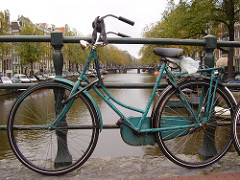Book Review: In the City of Bikes by Jordan Posted by Karoly Molina on Sep 29, 2016 in Culture, Dutch Vocabulary
There is a section at the gift shop of the Rijksmuseum that has books about the Netherlands in different languages (mostly English and French). Every time I am in the neighborhood, I check the selection and purchase one or two books. On one of those trips, I purchased In the City of Bikes: The Story of the Amsterdam Cyclist and brought it home. It sat for a good while until I finally thought of giving it a chance. Perhaps I was skeptical because I prefer fiction. Perhaps the bike topic seemed to obvious. Little did I know then that this book would become one of the funnest reads ever!
Once I started reading, Jordan’s narrative quickly took hold of me and didn’t let go. The history of bikes in the Netherlands, and specifically in Amsterdam, was truly captivating and often times funny. Instead of doing a usual summary, I will simply share with you a few interesting facts and anecdotes from the book.
- In May 1922, Amsterdam’s traffic police were tired of the cyclist who rode to fast and had no regard for the safety of others. They decided to fine the cyclists who were speeding on the Utrechtsestraat. One cop would click a stopwatch to time the cyclist and if the cyclist crossed the 100 meter stretch under 30 seconds, a second cop would signal a third cop and then the cyclist was fined. Although that first day about 100 cyclists were ticketed, cyclists quickly learned to look out for the “undercover” police and slow down.
- At around the same time period, the number of cars in the world had reached 25 million, 80% of which where in the U.S. In the U.S., there was one car for every 6 people, in Canada there was one car for every 13, in France one car for every 53 people. In the Netherlands, there was one car for every 185 people, while there was one bike for every 3.25 people!
- When the Spanish philosopher José Ortega y Gasset was in Amsterdam, he was disgusted by the abundance of bikes everywhere. “He found the sight of bare-legged female cyclists to be vulgar.”
- The rationing system implemented during the Second World War also included bicycle tires. People were asked to take care of their tires, and, at first, only those living more than three miles from his place of work would receive replacements. Eventually, no one had replacement tires.
- “The Dutchman is a modern centaur who was born with half his body human and the other half a bicycle; he possesses two feet and two wheels, a mouth for talking and a horn for making his fellow beings move aside.” -An American in 1972
- Other animal-related descriptions of Amsterdam cyclists are the bacteria of the street, the black sheep, lurking hyenas, hornets, street flees, over-grown vermin, big game, melancholy swans, and cockroaches.
While the novel does fall into some stereotypes and clichés about bikes and the Netherlands, it is a very entertaining read. The last time I was in Amsterdam, I appreciated the cyclists a little bit more!
What is your favorite bike-related read?
Useful Vocabulary:
de fiets- the bike
fietsen- to cycle
de fietser– cyclist
het fietspad– the bicycle lane
de snelheid– the speed limit
de boete– the fine
het rantsoen- the ration
de centaur- the centaur
de bacterie- the bacteria
het zwarte schaap- the black sheep
de hyena- the hyena
de vlo- the flee
het ongedierte- the vermin
de zwaan- the swan
de kakkerlak- the cockroach

Build vocabulary, practice pronunciation, and more with Transparent Language Online. Available anytime, anywhere, on any device.
About the Author: Karoly Molina
Since I was a little girl, I was fascinated with languages and writing. I speak English, Spanish, Italian, Dutch and a little bit of French. I am a writer, reader, language teacher, traveler, and a food lover! I now live in The Netherlands with my husband Riccardo, our cat Mona, and our dog Lisa, and the experience has been phenomenal. The Dutch culture is an exciting sometimes topsy-turvy world that I am happily exploring!




